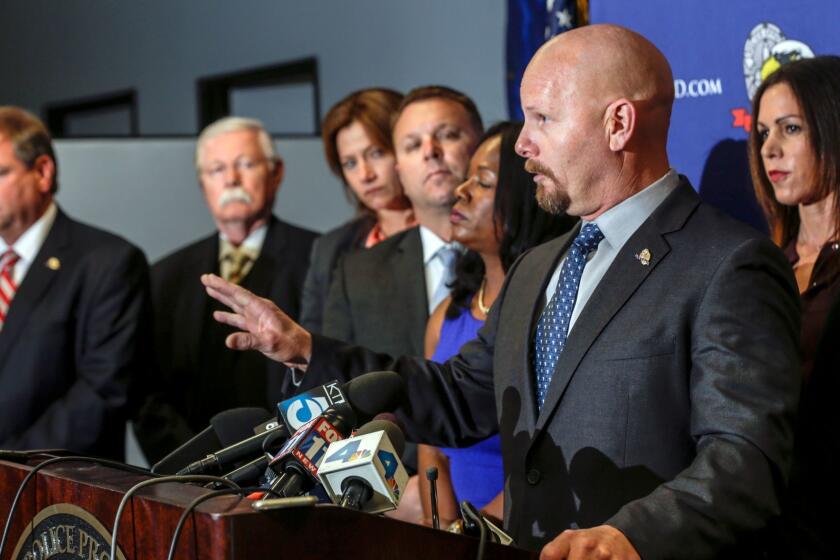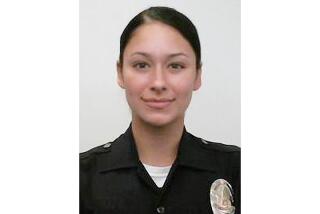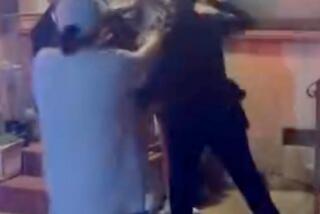She was known as a ‘top shot.’ Now an L.A. cop is at the center of a deadly shooting
Just 23 years old and near the start of her life in law enforcement, Toni McBride brimmed with youthful exuberance. A slew of online videos show the Los Angeles Police Department officer blasting away at targets, with prize-winning speed and accuracy, on a gun range in the Simi Valley foothills.
McBride, an officer in LAPD’s Newton Division, fired an array of shotguns, pistols and assault rifles. She cavorted and strutted, sometimes within view of Hollywood glitterati, who used the same firing range to hone the gunplay they would use for movies and TV. When star Keanu Reeves shouted out to her LAPD division in one video, the young cop laughed with delight. “Hey, he knows!” she said, clapping. “Shootin’ Newton!”
But less than two weeks after the posting of that video, McBride’s gun use turned deadly earnest.
In the middle of a scruffy street south of downtown on April 22, she faced off with a man holding a razor box cutter. She fired six shots from her Glock 17, hitting Daniel Hernandez with every round and killing the 38-year-old carpet installer and father of a teenage daughter.
Though Hernandez’s family quickly protested that McBride used excessive force, the incident gained wider attention only a month later, after the killing of George Floyd provoked a national furor over police behavior. Now Hernandez’s death has become a cause celebre, protested by Black Lives Matter and questioned by a candidate for district attorney.
McBride’s supporters defend her as an officer trying to protect herself and the public from a dangerous man. Hernandez’s family and their lawyers say the shooting epitomizes the blind use of force that has haunted Black and Latino communities for generations.
“Do we want police officers to be gunslingers, or to live up to the LAPD motto, ‘to protect and to serve’?” said Arnoldo Casillas, an attorney representing the Hernandez family.
Police use-of-force expert Ed Obayashi defended McBride as an officer doing her job, in what he called “a clear-cut justified shooting.” Obayashi said he was persuaded after watching video of the incident. “There is absolutely no doubt in my mind,” he said, “this officer was facing an immediate threat to her life.”
Jamie McBride is an unrepentant backer of old-school policing. He loves former chief Daryl Gates. He says Black Lives Matter is the real problem. And he is the recent face of the LAPD union.
McBride and her actions have provoked intense discussion partly because of her lineage. Her father, Jamie, is one of nine directors of the LAPD’s powerful labor union and was involved in six shootings during his first 11 years on the job.
Loyalists say the younger McBride shouldn’t be judged by the acts of her father, good or bad. Critics, including Los Angeles County district attorney candidate George Gascon, say the elder McBride’s influence will make it hard for the Hernandez family to get a fair hearing. They have called for the state attorney general’s office to step into the investigation.
But police experienced with local procedure say the city’s system for reviewing deadly force promises to be painstaking, involving the department’s Force Investigation Division, the independent Inspector General, Chief of Police Michel Moore, the civilian Police Commission and the district attorney’s office. Those reviews could take a year.
McBride, now back on regular patrol duty, has been immersed in a world of policing since her childhood growing up in Ventura County, where she would dress up in her dad’s uniform. She entered the Police Academy at 20 and became “top shot” in her class, according to a doting cover profile in The Blue Press, a catalog for a firearms ammunition company.
She later practiced her shooting at Taran Tactical Innovations, a Simi Valley shooting range and gun outlet owned by Taran Butler. Butler crams his company’s social media channels with videos of uber-fit models and actresses shooting at dummies and other targets. Usually they race against a stopwatch.
“That’s what I’m known for,” Butler told Los Angeles magazine. “Beautiful girls who shoot as good as they look.”
McBride’s appearances with celebrities such as Reeves and former Lakers star Rick Fox attracted scores of fanboys, who showered her with an online marriage proposal and compliments about her “#badass” ways. One follower deemed McBride the “#HottestCopEver.”
But the Hernandez family contends that the frothy, rapid-fire videos exhibit a kind of gun use not consistent with LAPD policy, requiring measured and deliberate force.
Butler did not return a phone call requesting comment for this article. Attorney Larry Hanna said his client, McBride, behaved admirably in a complex and fast-evolving scene that led to the confrontation with Hernandez.
Video from the scene records McBride’s multiple orders to Hernandez to desist and to drop the knife. (Actually a razor cutter like the one that Hernandez carried for his carpet installation work, his family said.) She hewed closely to her LAPD training and can be seen on video, Hanna said, “doing everything she can to deescalate this situation.”
Central in the review of the episode will be video, both from McBride’s body camera and from the mobile phones of two civilians.
The recordings reveal a chaotic scene early on the evening of April 22, in the middle of San Pedro Street near East 32nd Street. Witnesses recalled that Hernandez sped north up the busy street in a black pickup, crashing into another car and unleashing a five-vehicle chain reaction.
A coroner’s autopsy would later show that Hernandez had methamphetamine in his system. Witnesses said he rejected any assistance and appeared to be cutting himself in the cab of his truck. (A medical examiner later noted cut marks on Hernandez’s forearms.)
In the roughly 75 seconds from the time she stepped out of her patrol car until she fired her first shot, McBride had to process a multitude of information: dispatch reports from a police operator, shouts of some of the dozens of bystanders and a report that the pickup driver was trying to hurt himself.
McBride quickly requested backup. She called out to her partner, “Do we have less-lethal?” Police squad cars are outfitted with bean bag shotguns or foam projectile launchers. McBride’s query about alternative weapons apparently went unanswered.
Over the course of roughly 15 seconds, she tried to deter Hernandez with a series of seven voice commands, first, “Let me see your hands!” then, “Stay right there!” Then, three times: “Drop the knife!”
Hernandez kept moving slowly toward her, throwing both arms out from his sides. McBride commanded, “Drop it!” a final time, a split second before firing two shots. Hernandez keeled forward to the asphalt, but quickly pushed himself up and forward. McBride fired two more rounds, then the final two as Hernandez rolled on the ground.

McBride’s decision-making will be broken down and analyzed, shot by shot. The LAPD’s use-of-force policy says the officer’s judgment will be assessed “from the perspective of a reasonable Los Angeles police officer with similar training and experience, in the same situation.”
An officer must reasonably believe he or she needed to use deadly force “to defend against an imminent threat of death or serious bodily injury to the officer or to another person.”
Hernandez’s parents and 14-year-old daughter argue, through their attorneys, that McBride could have done more to deescalate the confrontation. She might, for example, have stepped behind a bystander’s car to buy time, they say. They contend that she responded like the competitive shooter seen on video, racing to get off shots.
“She loves to shoot all these things as fast as she can,” said Casillas, the lawyer for Hernandez’s family. “That certainly is in stark contrast to the measured, cautious police officer, exhibiting a reverence for life. This isn’t a movie.”
But Hanna, McBride’s lawyer, counters that the officer had little choice, faced off against an oncoming man with a weapon, who posed an imminent threat. He added that McBride worked hard to master all aspects of her training, including deescalation techniques, threat assessment and shooting skills.
“She had fear at all times and was shooting at somebody she felt was coming at her and ... toward the other citizens who were out there,” Hanna said, calling arguments to the contrary “playing politics.”
The echo of McBride’s shots had scarcely faded when a debate about the shooting began along the garbage-strewn stretch of San Pedro Street where Hernandez died.
A bystander shot video of the confrontation, broadcasting it live on Facebook. “They didn’t have to shoot!” one man says in Spanish to the videographer, who retorts: “No, they did. He had a knife. He was walking toward her.”
The shooting felt unnecessary to some of the people living in motor homes and trailers along San Pedro Street.
Israel Espinoza, 75, said he briefly talked to Hernandez just after his smashed car came to a stop. He saw the box cutter Hernandez was carrying and thought it was not dangerous.
Yolanda Madison, 56, said she also talked to Hernandez as he exited his pickup truck. “I told him to surrender or they were going to shoot him,” Madison said.
“Did they have to shoot him six times? Did they have to shoot him while he was down?” Espinoza asked. “They even cuffed him after he was dead. That’s what we are to the police, dead meat.”
Obayashi, the use-of-force advisor to a statewide association of police training officers, called Hernandez’s actions — advancing toward the officer and then springing upward, even after being shot — “violently aggressive.” He said McBride had no choice but to “end the threat” when Hernandez lurched forward, even after being shot twice.
Their brief encounter on the streets of Los Angeles would resonate months later, especially for McBride and for Hernandez’s family.
Eleven years earlier, Hernandez had been at home when he claimed to have inadvertently sprayed an LAPD officer with a garden hose. The officer had arrived to question the family for drinking in public, on their front porch.
Officers pepper-sprayed him, dragged him to a children’s swimming pool and forced his head into the water, according to a lawsuit filed by Hernandez. When he said he couldn’t breathe, the officers allegedly laughed and dunked his head again.
The lawsuit was dismissed.
Hernandez had remained at the same South Los Angeles home, living with his parents and working in the family’s flooring business. He had been talking excitedly about the grand quinceanera celebration he planned to mark his daughter’s 15th birthday later this year. “He lived for her,” said the girl’s mother, Claudia Sugey Chavez.
Shooting incidents are stomach-churning events for all officers, McBride’s lawyer said. For her, the April 22 incident “has been very hard” and one she hopes she will never have to repeat. But her commitment to being a police officer, to “help people who can’t help themselves,” has not wavered, Hanna said.
Since the shooting, McBride has taken down Instagram posts that had attracted nearly 47,000 followers. In one of the postings still visible on web archives, McBride says: “I can honestly say that I absolutely love my job and can’t see myself doing anything else.”
More to Read
Sign up for Essential California
The most important California stories and recommendations in your inbox every morning.
You may occasionally receive promotional content from the Los Angeles Times.













